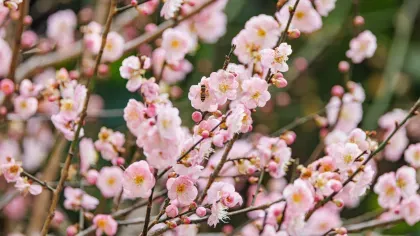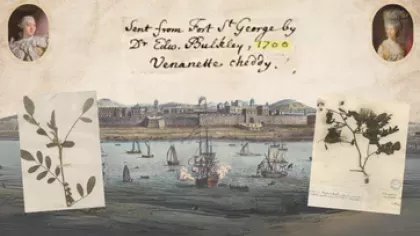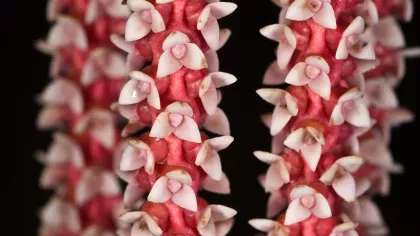25 June 2015
Wood identification supports legal timber trade
Kew botanist Peter Gasson reveals the key role that wood identification plays in supporting the legal trade of timber and its products.

The importance of wood
We all rely on wood wherever we are in the world. Wood is the most important inedible renewable resource on the planet, with many uses. Why wood plays such a large part in our lives hardly needs explaining, whether we are in a wooden hut in the polar regions where trees can’t grow and it has to be imported, or writing a note on a piece of paper. There is immense demand worldwide for wood and its products, and although there are FAO figures for the value and volume of international trade and domestic consumption (see link below), they cannot take into account illegal trade.
What is wood?
Before revealing Kew’s role in wood and its trade, I need to explain exactly what wood is and isn’t! From a botanist’s point of view wood is secondary xylem, the product of a lateral meristem called the vascular cambium (meristematic tissue is made up of cells that divide, the plant equivalent of stem cells in animals).
In a tree or shrub, the vascular cambium forms a sheath between the bark and wood, dividing inwards to form the secondary xylem (wood), which has the dual purpose of supporting the plant and conducting water and nutrients up the stem, and secondary phloem outwards, which transports sugars down the plant from the leaves towards the roots, diverting where necessary to all the living tissues of the plant. Secondary xylem is found only in conifers (softwoods), and in woody dicotyledonous angiosperms (hardwoods). Palms (including rattans) and bamboos, which are monocotyledons, do not have a vascular cambium and their stem tissue is the product of the apical meristem. Consequently there is no secondary xylem, although they can certainly be 'woody' and can have similar uses to true wood, for example flooring.
The role of reference collections
So where do Kew’s interests in wood lie? We frequently receive wood samples for identification. Two questions that constantly arise are what is this wood and where is it from? We are in an ideal situation to address these questions because we have one of the best collections of wood samples in the world (see Index Xylariorum 4 in the links below, which gives details of Kew’s and the other major institutional xylaria worldwide), an extensive microscope slide collection of sections of these woods, and expertise built up over many decades to identify unknown samples. We also constantly use the wood identification website Inside Wood, which provides inspiration and thousands of photographs of wood sections from most of the world’s wood anatomists, including those from Kew.
Reference collections have an essential role to play in achieving the aim that wood is traded and used honestly and sustainably. We use these collections for research on plant structures (see Cornish et al. 2013a,b, 2014 and references therein), and to identify plant material for a wide range of enquirers including palaeontologists, archaeologists, antique dealers, furniture restorers, medics, vets, the police and customs. Our first recorded anatomical enquiry was answered by C.R. Metcalfe in August 1932 (Keeper of the Jodrell Laboratory 1930–1969), and we have identified vegetative plant material, especially woods, ever since. In the last few years the number of enquiries regarding CITES-listed timber species has increased, and with the introduction of the European Union Timber Regulations (EUTR) in 2013, many enquiries concern the identity of commercial timbers imported to the UK as furniture or in plywood.
Identifying wood
So how do we identify a piece of wood? The naked eye or hand lens is usually sufficient to tell the difference between a softwood and a hardwood, and some softwoods such as pine (Pinus sp.) and hardwoods such as oak (Quercus sp.) or beech (Fagus sp.) can be recognised with a little practice. However, for a more precise identification we resort to light microscopy. We firstly soften a sample of the wood by boiling it in water. Lightweight balsawood (Ochroma sp.) takes only a few minutes to soften, but very dense and heavy woods such as ebony (Diospyros sp.) may take several days and more extreme measures such as microwaving or treatment with chemicals might be necessary. Once softened we cut sections in three planes using a microtome and examine them under a light microscope (see accompanying photos of transverse (TS), tangential longitudinal (TLS) and radial longitudinal sections (RLS)).
Challenges
Complex trade patterns
There are hundreds of tropical timbers, and identifying them is much more challenging than for temperate ones, especially if their origin is unknown. This is increasingly the case with trees being harvested in one country, exported to another often on a different continent, and then exported to another as a finished product, where following a chain of custody is problematic (FSC – Forest Stewardship Council, and PEFC – Programme for the Endorsement of Forest Certification are schemes that partly address this problem, but they are not legally binding). These complex trade patterns are also troublesome for importers, who are legally required to use ‘due diligence’ to show that their timber products have been legally sourced. In an effort to reduce illegal trading, there is now legislation in much of the western world: European Union Timber Regulations (EUTR), the US Lacey Act and the Australian Illegal Logging Prohibition Act.
Plywood, chipboard and MDF
Solid pieces of wood are the most straightforward to identify. However, many wood products are in the form of plywood, chipboard or MDF (medium density fibreboard). Hardwood plywoods manufactured in China can be particularly challenging. Their face veneers are only about 200 µm thick (i.e. one fifth of one mm!) and are usually pale red or pink, and being rotary cut present a tangential surface. This is fortunate, since oblique longitudinal sections or planes, which often look good as furniture veneer, can be almost impossible to identify. The veneers are so thin that we can only section the tangential plane and imagine what the transverse and radial planes would look like. So far we have identified them as Palaquium (from the Solomon Islands), Canarium, Campnosperma, Sterculia (West Africa), stained Populus (China), Eucalyptus (originally Australian but grown worldwide and in this case in China) or Entandrophragma (West Africa). The inner layers are mainly Eucalyptus or Populus grown in China.
Solid wood products have included oaks from North America and the Far East (Quercus alba, Q. robur/petraea, Q. mongolica), ‘Brazilian pine’ (Pinus taeda or P. elliottii), Albizia saman, walnut (Juglans mandschurica), beech (Fagus), ash (Fraxinus), alder (Alnus), acacia, rubberwood (Hevea) and Dipterocarpaceae.
Confusing common names
If you wander around department or DIY stores you will often come across wood products with a common or trade name which can be misleading. A few examples make this point: cedar (the softwood Cedrus or hardwood Cedrela), pencil cedar (the softwood Juniperus or hardwood Palaquium), and ‘Brazilian pine’ (there are no native pines in Brazil - this name refers to Pinus taeda and P. elliottii from North America which are grown in plantations in Brazil. Many other of the 110 or so Pinus species are grown worldwide outside their natural range. The best known is Pinus radiata that forms the largest planted forest in the world, in New Zealand), and mahogany (Swietenia, Khaya, Entandrophragma and many other Meliaceae and unrelated hardwoods that are reddish in colour).
Promising new techniques
Wood samples can usually be identified to genus (sometimes only family) but ascertaining geographical origin usually requires stable isotope techniques unless assumptions can be made. Molecular methods show promise in identifying taxa to species, especially if sapwood is present, but adequate reference datasets still do not exist, especially for large genera such as Quercus (525 species from the Colombian Andes across the northern hemisphere to Japan) and Dalbergia (250 species, pantropical). Heartwood, and especially heated and glued plywoods and composites will still be particularly problematic even with new molecular techniques, and chemical profiling using various mass spectrometry and near infrared spectroscopy techniques show promise. Many more taxa will be encountered in the future, and keeping up with trade patterns and the timbers harvested will be a major challenge for all concerned. There’s a lot still to do!
References
Cornish, C., Gasson, P. & Nesbitt, M. (2013a). The wood collections at Kew: from toys to totem poles (Part I). World of Wood 66(3): 14-16.
Cornish, C., Gasson, P. & Nesbitt, M. (2013b). The wood collections at Kew: current status and activity (Part II). World of Wood 66(4): 14-15.
Cornish, C., Gasson, P. & Nesbitt, M. (2014). The wood collection (xylarium) of the Royal Botanic Gardens, Kew. IAWA Journal 35(1): 85-104.
Gasson, P. (2011). How precise can wood identification be? Wood anatomy’s role in support of the legal timber trade, especially CITES. IAWA Journal 32(2): 137-154.
Gasson, P., Baas, P. & Wheeler, E. (2011). Wood anatomy of CITES-listed tree species. IAWA Journal 32(2): 155-197.
Lynch, A.H. & Gasson, P. E. (2010). Index Xylariorum - Edition 4. Royal Botanic Gardens, Kew. Available online
White, L. & Gasson, P. (2008). Mahogany. Kew Publishing. 100 pages.
Wiedenhoeft, A. C. & Baas, P. (editors) (2011). Wood Science for Promoting Legal Timber Harvest. IAWA Journal 32(2): 121-297. Also issued separately as a book.






